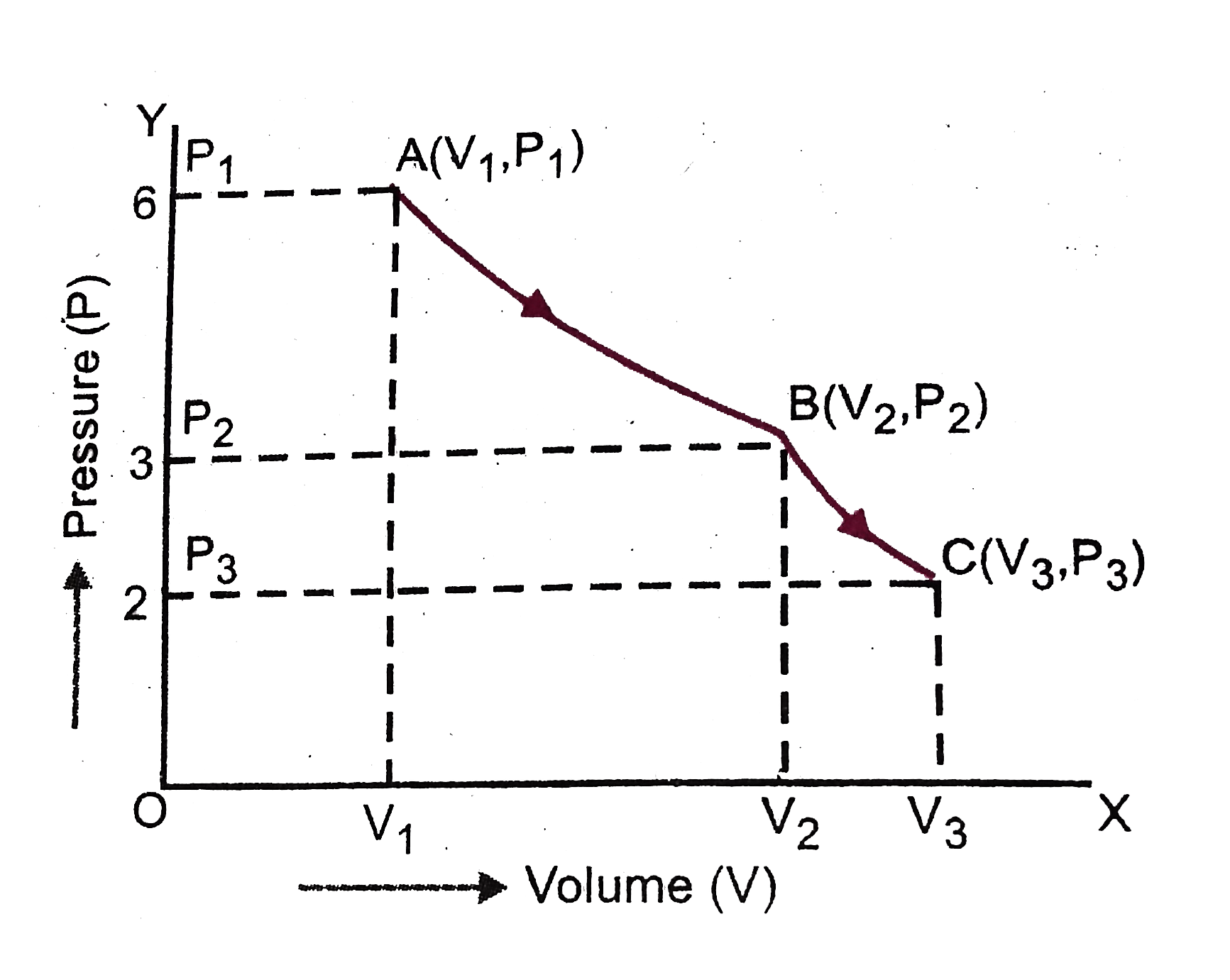The initial volume of an ideal gas is V1 and the initial pressure is P1=6 atmosphere. It expands isothermally to a volume V2 and pressure P2=3atm, and then adiabatically to a volume V3 and pressure P3=2atm. Draw a rough sketch of these changes. Calculate the value of V2/V1andV3/V2.
Take γ=1.4.
In (figure), initial state of gas is represented by A (V1,P1). AB represents isothermal change to B (V2,P2)
BC represents adiabatic change from B(V2,P2) to C(V3,P3).
As change from A to B is isothermal
∴P1V1=P2V2orV2V1=P1P2=63=2
As change from B to C is adiabatic,
∴P2Vγ2=P3Vγ3or(V3V2)γ=P2P3
or V3V2=(P2P3)1/γ=(32)1/γ=(1.5)1/γ=(1.5)1/1.4=(1.5)5/7=1.33

Topper's Solved these Questions
- THERMODYNAMICSBook:PRADEEPChapter:THERMODYNAMICSExercise:Value based Questions
Explore 4 Videos
- THERMODYNAMICSBook:PRADEEPChapter:THERMODYNAMICSExercise:NCERT Questions
Explore 10 Videos
- THERMODYNAMICSBook:PRADEEPChapter:THERMODYNAMICSExercise:Long answer questions(NCERT)
Explore 5 Videos
- SYSTEMS OF PARTICLES AND ROTATIONAL MOTIONBook:PRADEEPChapter:SYSTEMS OF PARTICLES AND ROTATIONAL MOTIONExercise:Assertion- Reason Type questions
Explore 20 Videos
- WORK, ENERGY AND POWERBook:PRADEEPChapter:WORK, ENERGY AND POWERExercise:Assertion-Reason Type Questions
Explore 24 Videos
Similar Questions
If a gas of a volume V1 at pressure p1 is compressed adiabatically to volume V2 and pressure p2, calculate the work done by the gas.
View SolutionAn ideal gas with pressure P, volume V and temperature T is expanded isothermically to a volume 2V and a final pressure Pi, If the same gas is expanded adiabatically to a volume 2V, the final pressure Pa. The ratio of the specific heats of the gas is 1.67. The ratio PaP1 is .......
View Solution
Knowledge Check
A monatomic gas at a pressure P, having a volume V expands isothermally to a volume 2 V and then adiabatically to a volume 16 V. The final pressure of the gas is ( take γ=53)
A64 PB32 PCP64D16 PA monatomic gas at a pressure P, having a volume V expands isothermally to a volume 2 V and then adiabatically to a volume 16 V. The final pressure of the gas is ( take γ=53)
A64 PB32 PCP/64D16 PAn ideal gas with pressure P, volume V and temperature T is expanded isothermally to a volume 2V and a final pressure P1. The same gas is expanded adiabatically to a volume 2V, the final final pressure is PA. In terms of the ratio of the two specific heats for the gas γ, the ratio PI/PA is
A2γ−1B21−γC2γD2γ
An ideal gas with pressure P, volume V and temperature T is expanded isothermally to a volume 2V and final pressure PI. The same gas is expanded adiabatically to a volume 2V and final pressure in this case is PA. In terms of the ratio of the two specific heats for the gas γ, the ratio PI/PA is
View SolutionA monatomic gas at a pressure P, having a volume V expands isothermally to a volume 2 V and then adiabatically to a volume 16 V. The final pressure of the gas is ( take γ=53)
View SolutionA monoatomic gas at a pressure P, having a volume V expands isothermally to a volume 2V and then adiabatically to a volume 16 V. The final pressure of the gas is (Take γ=5/3)
View SolutionAn ideal gas with pressure P, volume V and temperature T is expanded isothermally to a volume 2V and final pressure PI. The same gas is expanded adiabatically to a volume 2V and final pressure in this case is PA. In terms of the ratio of the two specific heats for the gas γ, the ratio PI/PA is
View SolutionAn ideal gas of volume V and pressure P expands isothermally to volume 16 V and then compressed adiabatically to volume V . The final pressure of gas is [γ=1.5]
View Solution
